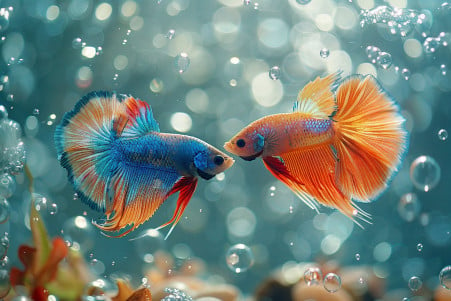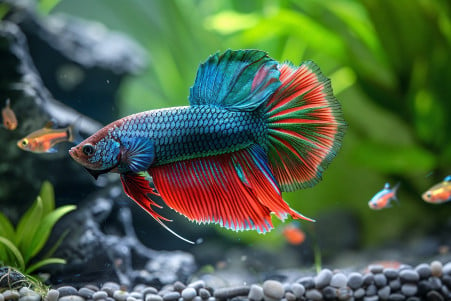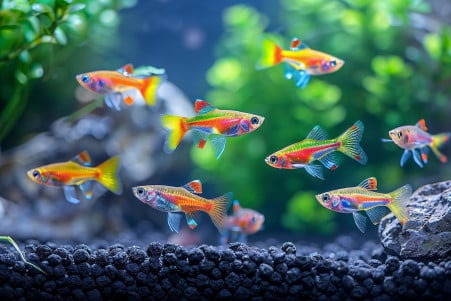Guppy Mating Behavior: A Detailed Overview
3 May 2024 • Updated 1 May 2024

Have you ever wondered how those little guppies in your aquarium are able to have so many babies? One of the most interesting things about guppies is their mating behavior. Male guppies use a special mating technique called gonopodial thrusting to inseminate females internally.
But that's not the only interesting thing about guppy mating. In this article, we'll look at guppy mating behavior from an ethological, evolutionary, and animal behavior perspective. We'll discuss the many ways guppies have evolved to ensure reproductive success. This will include a look at the complex courtship behaviors, the criteria guppies use to choose their mates, and the way guppy coloration has evolved to attract potential mates. We'll also discuss the environmental and selective factors that have influenced the evolution of guppy mating behavior.
How do guppies mate?
Male Guppy Courtship Displays
The male guppy uses a complex courtship display to attract females, including a series of "dances" around the female, as explained in the National Science Foundation's article. If the female is interested, she will move closer to the male. These displays are designed to show off the male's bright colors and patterns, which are important factors in female guppies' choice of mates.
The courtship displays are also influenced by environmental factors, including light and the presence of other males. As noted by Tropical Fish Hobbyist Magazine, the male's anal fin has evolved into a specialized gonopodium that is used to transfer sperm to the female during mating. The gonopodium's hooked tip allows the male to hold the female in place during insemination.
These complex courtship displays help ensure the male's reproductive success and increase genetic diversity within guppy communities. More recent research has delved into the cognitive processes involved in these displays, with studies suggesting that guppies take into account a number of factors, including color, behavior, and past experiences, when choosing a mate.
By mating with males that display new colors and patterns, female guppies avoid inbreeding and introduce new genetic material into the community. These mating behaviors have evolved in response to the need to produce the most viable offspring, which has helped ensure the long-term survival of this fascinating species.
Mate Selection Criteria: The Role of Coloration and Novelty
Bright colors and bold patterns are important to female guppies when it comes to choosing a mate, as noted in research from the National Science Foundation. In fact, females tend to prefer males with new or different color patterns, a concept that has important evolutionary implications.
As Emerald King Aquatics explains, the genetics of guppy coloration are very complicated and involve dominant and recessive genes on the X and Y chromosomes. As a result, there are many different color patterns that can be created through selective breeding.
One interesting thing that has been discovered is that female guppies can become "habituated" to a familiar color pattern, meaning that they lose interest in it until they are isolated and then reintroduced to the pattern, according to a study published in Proceedings of the Royal Society B. This is an important way that guppies ensure genetic diversity and avoid inbreeding in their populations.
Additional research outlined in Zoological Science has shown that the genetic basis of the variegated tail patterns that are so popular with guppy enthusiasts is also very complicated. This research has shown that the inheritance of these patterns is also very complicated, which helps explain how the criteria for mate selection have shaped the evolution of guppy coloration.
By choosing novel mates, female guppies ensure that new genetic mutations are introduced into the population, which increases the overall genetic diversity and adaptability of the species. This is just one example of how the genetics of guppies and their mate selection criteria interact and influence one another.
Tank Requirements and Water Conditions for Breeding Guppies
Guppies are known for being easy to breed in captivity, but the right tank setup is essential for successful breeding. According to the Aquarium Co-Op, guppies should be kept in a tank that is at least 10 gallons, although a minimum of 20 gallons is recommended for a dedicated breeding setup to ensure there is enough room for the fish to swim and enough water volume.
Water should be slightly alkaline with a pH between 6.8-7.8 and the temperature should be kept between 72-82°F, according to Aquatic Live Food. A high-quality hang-on-back or canister filter is a must to keep the water clean, especially since guppies are known for producing a lot of waste.
Hiding spots and live plants, such as Java moss or Anubias, are necessary for the survival of newborn guppy fry, according to the Petco care sheet. In addition, maintaining the right male-to-female ratio, which is often 1:2 or 1:3, and separating pregnant females can help prevent harassment or infanticide.
Guppies should be acclimated to new water conditions slowly to avoid stress, and partial water changes of 25-50% should be performed on a regular basis, according to Light.Fish. By ensuring the right breeding conditions, hobbyists can increase the likelihood of successfully breeding and raising healthy guppy fry.
How to Take Care of Guppy Fry and Help Them Grow
Taking care of guppy fry and helping them grow to maturity requires special care and attention. According to wikiHow, it's important to make sure the guppy fry are in a stress-free environment with plenty of hiding places, such as artificial plants or pebbles, to help them grow. It's also important to make sure they have enough space, as overcrowding can lead to poor water quality and stunted growth.
To ensure that the guppy fry grow quickly, they should be fed a high-energy, nutritionally balanced diet three times a day in small portions, according to Hikari Sales USA. This can include crushed flakes, baby brine shrimp, and even flightless fruit flies. Good lighting and light aeration will also help keep the guppy fry healthy.
wikiHow Pet notes that it's important to separate the mother guppy from her fry as soon as she gives birth to prevent her from eating them. It's also important to watch the fry for signs of sickness or deformities, as any fry that appear to be unhealthy should be removed from the tank to prevent the spread of illness.
When the guppy fry are 6-8 weeks old and are larger than the adult guppies' mouths, they can be introduced to the main tank. However, this should be done gradually and carefully to ensure the guppy fry are safe and can successfully join the adult guppy community. With the right care and environment, guppy enthusiasts can help ensure the guppy fry grow and thrive.
Diseases That Affect Guppies and How to Prevent Them
Guppies are prone to a number of common diseases and health problems that can quickly spiral out of control if not properly managed. As noted by Aqueon, common stressors like poor water quality, incorrect water chemistry, and poor filtration are some of the main factors that can compromise a guppy's immune system and leave it susceptible to disease.
One of the most common diseases that affects guppies is ich, or white spot disease. As outlined by Tetra, ich is a parasitic disease that causes small white spots to appear on the fish's body and fins. Other symptoms include the fish rubbing against objects in the tank, rapid breathing, and a loss of appetite. Bacterial infections can also be a common problem, with fin rot and tail rot leading to the decay of the fins and tails.
To prevent these diseases, Guppy Aquarium recommends maintaining good water quality, quarantining new fish for at least two weeks before adding them to the main tank, and minimizing stress. If a disease does break out, it's important to treat it quickly with the right medications, salt baths, or a hospital tank. With a little bit of care, aquarium owners can ensure their guppies stay healthy and happy.
Conclusion: The Ongoing Intrigue of Guppy Mating Rituals
Guppy mating rituals are incredibly interesting, from the fish's unusual reproductive system to the complex courtship displays of the males. These small, brightly colored fish use a range of methods to ensure they pass on their genes, with the female's preference for new and bright color patterns playing a key role.
Guppy courtship involves a complex "dance" by the male, which shows off his bright colors and patterns to attract a female. The female's reaction to the male's displays, and her temporary habituation to familiar patterns, are evolutionarily advantageous and help ensure genetic diversity in the population.
Guppy mating behaviors are influenced by a combination of environmental factors, cognitive processes, and genetic factors. Viewing these behaviors through an interdisciplinary lens that includes the study of ethology, evolutionary biology, and animal behavior can help researchers learn more about the evolution of reproductive strategies and the importance of genetic diversity.
The ongoing intrigue of guppy mating rituals is due to their complexity and the insights they provide to science. By continuing to observe and research these small but amazing fish, we can learn more about the natural world and the many wonders it holds.


